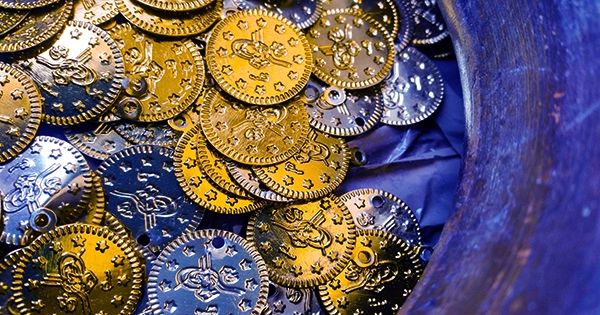During the 18th century, British trading abroad flourished. In 1756, Samuel Johnson observed, “There wasn’t from the earliest ages a time when trade so much engaged the interest of mankind.” This was especially true for trade with the United Kingdom’s rapidly growing colonial possessions in the Americas and Asia. Surging intercontinental trade provided a plethora of opportunities, not all of which were legitimate. Smugglers took advantage of the British government’s enforcement of high taxes on exotic food imports, particularly tea cultivated in China and imported by Europe’s East India trading corporations. Because customs taxes were so high and smugglers were so effective, there were times throughout the 18th century when more tea was smuggled than was officially imported.
However, smuggling was far from the only criminal activity that took advantage of the situation. Another was Yorkshire’s ‘yellow trade,’ the local term for the 1760s activity of clipping and counterfeiting gold coins in the Pennine Hills near Halifax in West Yorkshire. The yellow trade, like smuggled tea, was a smashing success. In the 18th century, gold guineas with a face value of 21 shillings (£1.05) accounted for the majority of the national currency by value. Clipping or forging guineas was high treason, punishable by death. Nonetheless, the activities of the Yorkshire coiners forced the British government to withdraw the entire nation’s gold currency from circulation, worth an enormous amount of £16.5 million at 18th-century values, in order for it to be re-minted in just over a decade, from 1765 to 1776.

The opportunity utilized by the yellow traders, like smuggling, stemmed from government policy. Gold coins effectively superseded silver coins as the British standard in the 18th century. This gold coinage was beaten, worn, and underweight, with significantly reduced gold content; gold guineas that were already 100 years old remained current. However, governments were inhibited from intervening due to the high cost of a general recall.
Counterfeiting has existed for as long as governments have issued coins. However, the type of counterfeiting practiced in the Yorkshire yellow trade was distinct. The majority of counterfeit coins in circulation in 18th-century Britain were made of base metals. They had almost no inherent value and were not intentionally accepted by the public. Yellow traders, on the other hand, made gold counterfeits. Their forgeries had intrinsic bullion values that were comparable to authentic gold coins in circulation in the 1760s. This was made possible because clipping and coining were merged in Yorkshire: gold clippings were remanufactured directly into counterfeit coins.
Clipping was the technique of removing thin slivers of gold off the edge of a gold coin, which was then repaired with a file and returned to circulation. Because Britain’s gold currency was worn and underweight, these cut pieces went unnoticed. The yellow dealers purchased clippings directly from the general public and paid a premium to anyone who lent them a true gold coin of sufficient quality to clip. The payment was made in clipped or counterfeit coins, which increased the coin’s acceptability in local circulation while also fostering popular support for the yellow trade in the region. Because of local clipping, good-quality guineas were lured into Yorkshire from all across the country. Yorkshire set the pace for the debasement of the national coinage, with good money following bad.
The coin most usually made from gold cuttings by Yorkshire coiners was not the British guinea, but the Portuguese moeda, known as a moidore in England. Alluvial gold was discovered around the end of the 17th century in the distant inland South American province of Minas Gerais, on the border of the Portuguese colony of Brazil. A 60-year gold boom followed. Tens of thousands, if not hundreds of thousands, of enslaved Africans, were transported to Minas Gerais to dig and pan for gold, which was then turned into Portuguese coins in either Brazil or Lisbon. The majority of the coins were then shipped to settle Portugal’s highly negative trade balance with Britain, its primary supply of wool and worsted textiles. This influx of Portuguese money aided in the establishment of the British gold standard. Indeed, so much Portuguese coin was transported to Britain that it was described in 1742 as “in great measure the current coin of the Kingdom.” However, because moidores remained a foreign currency, counterfeiting or clipping them was a non-capital offense rather than high treason.
Integration into the global economy was both a blessing and a curse. Economic vulnerability to wars or international financial crises went hand in hand with access to new markets. The Yorkshire yellow trade developed as an extreme local reaction to one of these crises. A severe local cash scarcity in the mid-1760s around Halifax, in Yorkshire’s worsted textile production sector, meant that coins worn or clipped to an exceptional degree, by as much as a quarter, had begun to be accepted in payment. They were mocked as ‘Yorkshire guineas’ and refused elsewhere, but as one official grumbled, ‘the want of cash… gave a currency to everything that had the face of a guinea’. The scarcity resulted from the local worsted industry’s reliance on markets across the Atlantic, particularly in Britain’s North American colonies. With the end of the Seven Years War, American demand plummeted. The outset of the disputes that would lead to the American Revolution exacerbated matters. New orders dried up, and American clients were unable to pay for supplies that had already been delivered on credit.
In this section of Yorkshire, the worsted industry was a thriving newcomer. It grew extremely swiftly from very humble beginnings over the first part of the century. Yorkshire produced almost half of the nation’s worsted cloth by 1770. The majority of its output was exported. When the region’s many small-scale textile firms faced ruin in the mid-1760s, the businesspeople who operated them seized the opportunity provided by the intense local cash crisis and led the switch to the yellow trade.
The yellow trade, like the global trading networks it was a part of, was managed by guys who already had cash and credit. Money, as Samuel Johnson noted in his views on business only a few years ago, is “the chief of the means of trade.”
















